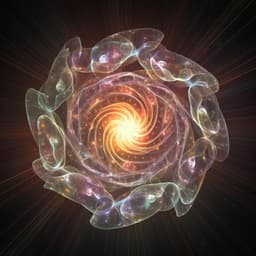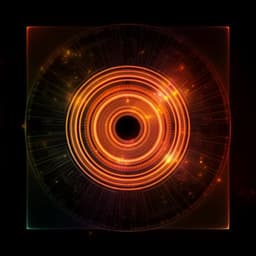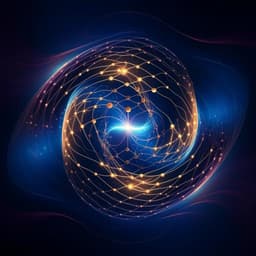
Engineering and Technology
Twisted moiré photonic crystal enabled optical vortex generation through bound states in the continuum
T. Zhang, K. Dong, et al.
This groundbreaking research by Tiancheng Zhang and colleagues uncovers a twist-enabled coupling mechanism in twisted bilayer photonic crystals that connects bound states in the continuum (BIC) modes to free space, paving the way for robust optical vortex generation—an exciting innovation for integrated optical information processing and optical tweezers.
~3 min • Beginner • English
Introduction
Moiré patterns in twisted bilayer van der Waals materials have revealed emergent electronic properties (e.g., moiré excitons, fractional Chern insulators, Mott insulators), and analogous moiré phenomena have been explored in photonics, including twist-induced flat bands, energy localization, and optical solitons. Twisting photonic structures breaks mirror symmetry and enables chiral optical properties. This study investigates whether structural chirality in twisted bilayer photonic crystals (TBPCs) can enable chiral light emission—specifically optical vortices carrying orbital angular momentum (OAM)—via bound states in the continuum (BICs). The central hypothesis is that a twist-enabled interlayer coupling (a moiré channel) can connect otherwise symmetry-protected BIC modes to free space through guided resonances, thereby generating robust optical vortex radiation with controllable topological order, independent of incident beam angle or position.
Literature Review
Prior work on moiré systems established rich electronic and photonic behaviors in twisted bilayers, including flat bands and localization in photonic moiré lattices and theoretical frameworks for twisted bilayer photonic crystal slabs. BICs and associated polarization vortices in momentum space have been experimentally observed, and chiral/quasi-BIC concepts have been introduced. Optical vortices carrying OAM have impacted imaging, communications, micromanipulation, and quantum information, with demonstrations of spin-to-orbital angular momentum conversion and entanglement. Previous optical vortex generators in microstructures often faced constraints (e.g., limited to even orders). A recent approach generated optical vortex beams via momentum-space polarization vortices around BICs. Building on these, the present work proposes twist-enabled interlayer coupling in TBPCs to directly excite BICs and radiate OAM-bearing vortices, achieving both odd and even topological orders with robustness to perturbations.
Methodology
System: Two photonic crystal (PhC) slabs composed of honeycomb arrays of silicon nanodisks are stacked with a small twist, forming a moiré superlattice (TBPC). The twist breaks short-range periodicity and twofold rotational symmetry protections that otherwise isolate Γ-point singlet BICs from free space.
Theoretical modeling: Using coupled-mode theory (CMT) for interacting resonators, the interlayer dynamics between modes a1 and a2 are described by first-order differential equations with identical eigenfrequencies and decay rates for identical disks, and symmetric intercoupling g. For a monolayer PhC, traveling modes with in-plane wavevector k are formed as linear combinations of disk modes. In non-twisted bilayers, the coupling intensity ζ(k) between a BIC in one layer and modes in the other is zero except at Γ, so BICs only couple to BICs. In TBPCs, the moiré structure introduces spatially varying interlayer coupling g(rj), yielding a nonzero ζ(k) away from Γ via ζ(k) = Σj exp(−ik·rj) g(rj). This establishes a twist-enabled moiré channel allowing BICs in one layer to couple to guided resonances in the other, which are radiative and connected to free space. The coupling ζ(k) is shown to be nearly identical for modes on a circular loop around Γ, implying similar phase and intensity.
Temporal coupled-mode theory (TCMT) analysis derives the excitation of guided resonances A(k) in one PhC by the BIC in the other with coupling γ(k) ~ ζ(k), and the outgoing radiation Eout = D A(k). Due to C3 symmetry in the honeycomb lattice, far-field states of polarization (SOPs) are linearly polarized with orientation θ(k). Decomposition into LCP and RCP components reveals that both acquire Pancharatnam–Berry phases tied to θ(k), producing a polarization vortex around Γ; consequently, real-space emission exhibits an optical vortex with topological charge l = ±q, where q is the BIC’s topological order (signs correspond to LCP/RCP components).
Numerical simulations: Full-wave simulations are performed. BIC electric-field distributions in monolayer PhCs (COMSOL Multiphysics) use Bloch boundary conditions (x, y) and PMLs (z), with silicon refractive index n = 3.47. Optical vortex emission from TBPCs is simulated with FDTD (Lumerical): a pulsed Gaussian beam excites the system, PMLs are applied in all directions, and far-field electric-field amplitude and phase are recorded on a plane 12 µm above the TBPC. A representative TBPC has 300 nm interlayer separation and 1.5° twist. Temporal evolution of emission is tracked to confirm the BIC-mediated mechanism and robustness to incident beam position/angle.
Key Findings
- Twist-enabled moiré channel: Theoretical CMT/TCMT shows that twisting breaks short-range periodicity, enabling finite coupling ζ(k) between the Γ-point BIC in one layer and guided resonances in the other, providing a pathway from BICs to free space via guided resonances.
- Optical vortex emission: Simulations of TBPCs excited by a pulsed Gaussian beam produce far-field beams with doughnut-shaped intensity and phase singularities (optical vortices), confirming OAM generation via the BIC-guided-resonance coupling.
- Spectral features: Two resonance peaks are identified at 193.4 THz and 211.2 THz with Q-factors of 3.1×10^3 and 3.4×10^3, respectively.
- Topological orders: For the RCP component, the observed vortex topological charges are l = −2 (peak i) and l = +1 (peak ii), matching the expected BIC topological orders in a honeycomb lattice (lowest orders −2 or 1). Both even and odd orders are achievable.
- Robustness: Vortex generation persists with varying interlayer separations (200–350 nm) and twist angles (1.0°–2.5°). For example, the LCP portion at peak ii consistently shows l = 1 across the tested parameter space, indicating robustness against geometric disturbances, fabrication errors, and thermal effects.
- Excitation insensitivity: Time-resolved simulations show that after initial excitation of multiple modes, low-Q modes decay and BIC-mediated radiation dominates, forming a vortex centered at the AA stacking region, independent of the incident beam’s position or angle. This indicates no stringent real-space or angular alignment is required.
- Application potential: High-Q vortex emission suggests suitability for vortex micro-lasers and integrated OAM photonics, with possible MEMS/NEMS-based tunability of twist and spacing.
Discussion
The study addresses the challenge of coupling symmetry-protected BICs to free space to generate structured light. By introducing a small twist between two PhC slabs, the moiré superlattice forms a new interlayer coupling channel that connects a Γ-point BIC in one layer to radiative guided resonances in the other. The momentum-space polarization vortex around the BIC imparts a Pancharatnam–Berry phase to LCP/RCP components, converting BIC energy into real-space optical vortices with well-defined topological charge. Full-wave simulations corroborate the theoretical model, showing high-Q vortex beams with both even and odd topological charges. Robustness against variations in twist angle, interlayer spacing, and excitation conditions indicates that the mechanism is intrinsic to the BIC–guided-resonance coupling mediated by the moiré channel, making practical implementation more feasible than approaches requiring precise alignment or specific incident conditions. The results are significant for photonic platforms seeking compact, stable, and tunable OAM sources, and they extend the concept of moiré physics to functional chiral light generation.
Conclusion
This work formulates and demonstrates a twist-enabled interlayer (moiré) channel in twisted bilayer photonic crystals that couples symmetry-protected BIC modes to free space via guided resonances, enabling robust optical vortex emission. Simulations reveal high-Q vortex beams with controllable topological orders, including both even and odd values, and robustness to geometric perturbations and excitation conditions. These findings position TBPCs as promising platforms for stable vortex generation and potential vortex lasers, with opportunities for tunability (via twist and spacing, e.g., with MEMS/NEMS) in quality factor, beam divergence, and vortex order. The approach broadens moiré photonics and may inform exploration of OAM phenomena in moiré van der Waals systems. Future research directions include experimental realization and characterization of TBPC-based vortex sources, integration into on-chip photonic circuits, active tuning mechanisms, and extension to different material platforms and wavelength ranges.
Limitations
The study is primarily theoretical and numerical; experimental demonstration of TBPC-based vortex generation is not reported here. Quantitative results are shown for specific geometries (e.g., honeycomb silicon nanodisk arrays, selected twist angles and interlayer separations) and rely on assumed material parameters (n = 3.47 for Si). While robustness is demonstrated across a tested parameter space, broader fabrication tolerances, disorder, and material losses beyond the modeled conditions remain to be validated experimentally.
Related Publications
Explore these studies to deepen your understanding of the subject.







